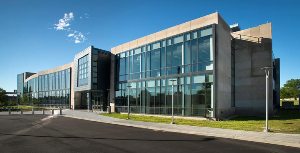Dec 20 2013
The Interdisciplinary Science Building (ISB) for energy research, the newest facility to open at the U.S. Department of Energy's Brookhaven National Laboratory, has been awarded a Leadership in Energy and Environmental Design (LEED) Gold rating for being "green." The U.S. Green Building Council awarded this designation for the ISB's energy-efficient and environmentally sustainable design, construction, and operations. The ISB is one of nine buildings at Brookhaven Lab to receive LEED certification.
 The Interdisciplinary Science Building (ISB) for energy research at Brookhaven Lab was awarded Leadership in Energy and Environmental Design (LEED) Gold certification for its energy-efficient and environmentally sustainable design, construction, and operations.
The Interdisciplinary Science Building (ISB) for energy research at Brookhaven Lab was awarded Leadership in Energy and Environmental Design (LEED) Gold certification for its energy-efficient and environmentally sustainable design, construction, and operations.
In this 87,700-square-foot facility, researchers in a wide variety of scientific disciplines are teaming up to tackle the nation's energy challenges. The building, which opened in April 2013, contains four specialized labs with unique features for safely assembling and testing new lithium-ion batteries, exploring materials' electronic structure at the atomic scale, and fabricating new materials one atomic layer at a time. The building also features offices and 60 standard laboratories.
To attain its LEED-gold certification, the ISB met internationally recognized standards defined by the U.S. Green Building Council. These standards include conserving energy; reducing water consumption; occupying a location previously developed to minimize environmental impacts; using certified, environmentally sustainable and recycled materials from sources less than 500 miles from the construction site to minimize transportation-related greenhouse gas emissions; and maintaining optimal indoor environments for building occupants.
"Constructing facilities like the Interdisciplinary Science Building to meet LEED certification standards and renovating older buildings on site are part of the Laboratory's long-term plans to provide scientists with modern, world-class research facilities while respecting the environment, meeting sustainability goals, and reducing energy costs," said Lanny Bates, Brookhaven Lab's Assistant Laboratory Director for Facilities & Operations.
Brookhaven Lab's Modernization Project Office managed the ISB design and oversaw its construction. The facility was designed by HDR Architecture, Inc. and general contractor E.W. Howell, Inc. built the structure. The total cost for the project was $66.8 million, most of which was provided by the DOE Office of Science. The Lab received approximately $18 million from the American Recovery and Reinvestment Act to accelerate ISB construction in April 2009.
Managing Environmental Impact Inside and Out
"Sustainable principles and environmental considerations guided our design concepts to ensure that the Interdisciplinary Science Building would be a high-performance facility for Brookhaven researchers working to reduce the carbon footprint of our energy economy," said ISB Project Manager Peggy Caradonna of the Lab's Modernization Project Office.
Built on the previous site of buildings from the World War I and World War II eras, when Brookhaven Lab was the U.S. Army's Camp Upton, the ISB employs a number of energy saving and environmentally friendly strategies. A white roof, insulation, and special window coatings reflect sunlight to cool the building in the summer and contain heat in the winter. A heat-recovery system, energy-efficient fume hoods, motion-sensing light controllers, low-flow toilets and other fixtures, storm water collection chambers, and many additional components contribute to a 37 percent increase in energy efficiency compared to conventional designs and a 55 percent reduction in potable water use. Exceeding federal mandates and Department of Energy directives for energy efficiency, the overall result is a cost avoidance of 29 percent when compared to benchmark laboratory designs.
DOE's Office of Science is the single largest supporter of basic research in the physical sciences in the United States, and is working to address some of the most pressing challenges of our time. For more information, please visit science.energy.gov.